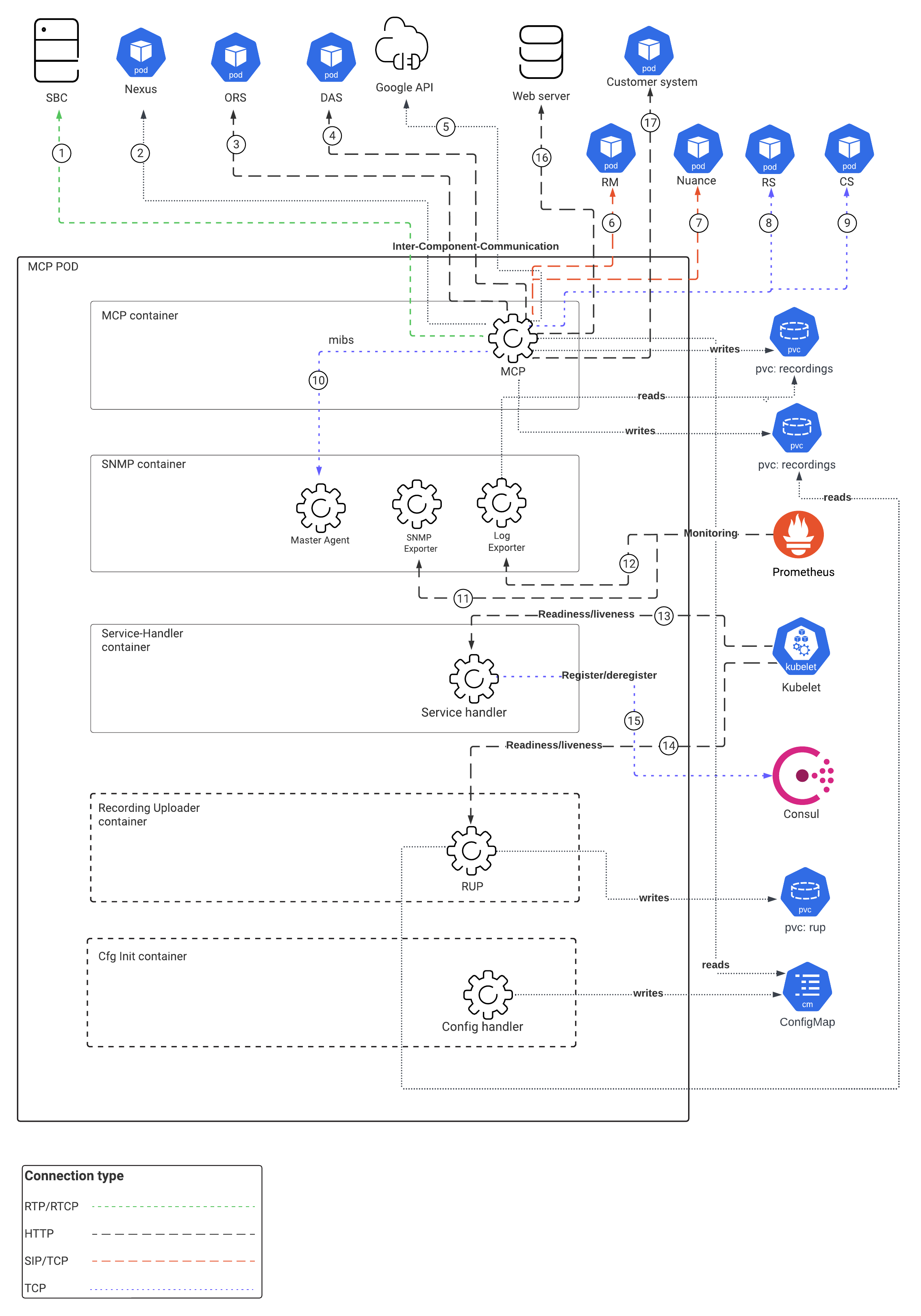Architecture - Media Control Platform
Learn about Genesys Voice Platform- media control platform architecture
Introduction
The following diagram displays the architecture for Media Control Platform.
For information about the overall architecture of Genesys Multicloud CX private edition, see the high-level Architecture page.
See also High availability and disaster recovery for information about high availability/disaster recovery architecture.
Architecture diagram — Connections
The numbers on the connection lines refer to the connection numbers in the table that follows the diagram. The direction of the arrows indicates where the connection is initiated (the source) and where an initiated connection connects to (the destination), from the point of view of Genesys Voice Platform as a service in the network.
Connections table
The connection numbers refer to the numbers on the connection lines in the diagram. The Source, Destination, and Connection Classification columns in the table relate to the direction of the arrows in the Connections diagram above: The source is where the connection is initiated, and the destination is where an initiated connection connects to, from the point of view of Genesys Voice Platform as a service in the network. Egress means the Genesys Voice Platform service is the source, and Ingress means the Genesys Voice Platform service is the destination. Intra-cluster means the connection is between services in the cluster.
| Connection | Source | Destination | Protocol | Port | Classification | Data that travels on this connection |
|---|---|---|---|---|---|---|
| 1 | MCP | SBC | RTP/RTCP | 20000-45000 | Egress | RTP messages. |
| 2 | MCP | Nexus | HTTP | 443 | Egress | Websocket messages. MCP connects to Nexus for Voicebot and Agent Assist services. |
| 3 | MCP | ORS | HTTP | 11200 | Egress | HTTP messages. |
| 4 | MCP | DAS | HTTP | 80 | Egress | HTTP messages. MCP connects to DAS to fetch VXML applications. |
| 5 | MCP | Google API | HTTP | 443 | Egress | GRPC messages. MCP connects to Google APIs for TTS service. |
| 6 | MCP | RM | SIP/TCP | 5060 | Egress | SIP Protocol messages. |
| 7 | MCP | Nuance | SIP/TCP | 5060 | Egress | SIP messages. Also, RTSP messages (protocol is RTSP and port is 14000-15999) and RTP (protocol is RTP and port is 20000-45000). MCP connects to Nuance for ASR/TTS services. |
| 8 | MCP | RS | TCP | 61616 | Egress | ActiveMQ messages. MCP posts billing data to RS. |
| 9 | MCP | CS | TCP | 8888 | Egress | TCP messages. MCP connects to configuration server to get recording certificate details. |
| 10 | MCP | Master Agent | TCP | 1705 | Egress | TCP messages. MCP posts SNMP metric and traps to SNMP MA. |
| 11 | Prometheus | SNMP Exporter | HTTP | 9116 | Ingress | HTTP messages. MCP Custom SNMP metric upload to Prometheus. |
| 12 | Prometheus | Log Exporter | HTTP | 8200 | Ingress | HTTP messages. MCP log metric upload to Prometheus. |
| 13 | Kubelet | Service Handler | HTTP | 8300 | Ingress | HTTP GET Requests and for liveness and readiness checks. |
| 14 | Kubelet | RUP | HTTP | 8080 | Ingress | HTTP GET Requests and for liveness and readiness checks. |
| 15 | Service Handler | Consul | TCP | 8500/8501 | Egress | TCP messages. Service Handler container inside MCP Registers MCP to the Consul. |
| 16 | MCP | Web server | HTTP | 80 | Egress | HTTP messages. MCP connects to web server to fetch vxml applications. |
| 17 | MCP | Customer system | HTTP/HTTPS | 80 | Egress | HTTP messages. |

